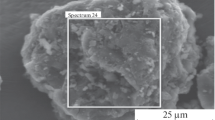Abstract
The comprehensive fuel characterization of newly discovered coals is critical to efficient energy recovery and effective utilization in various applications. Over the years, numerous coal deposits have been discovered in Nigeria, which has reignited interest in coal utilization. However, lack of comprehensive data on the new coals and their coking potential has hampered progress in the coal, iron, and steel industries in Nigeria. Therefore, this study examined the coke and energy recovery potential of a newly discovered lignite coal from Ogboligbo (OGB) in Kogi state of Nigeria through carbonization in a muffle furnace reactor. The pH, FTIR and TGA analyses of OGB and the derived cokes were subsequently examined in detail. The results demonstrated that temperature significantly influenced the carbonization process resulting in a coke yield, energy yield, higher heating value, and thermal properties markedly different from OGB. The pH analysis revealed weakly to strongly acidic cokes indicating their limited application to energy, steel, and iron manufacturing. The FTIR analysis showed that OGB and cokes structures consist of clay and silicate minerals such as kaolinite and illite. Lastly, the results showed that the carbonization process adversely affected the thermochemical reactivity of the cokes due to low moisture and volatile matter. However, the risks of self-ignition or spontaneous combustion are minimised after carbonization.






Similar content being viewed by others
REFERENCES
BP Statistical Review of World Energy 2017, London: British Petroleum, 2018, no. 66.
The future of coal: An interdisciplinary MIT study, Massachusetts Institute of Technology, 2007. https://web.mit.edu/coal/The_Future_of_Coal.pdf. Accessed October 6, 2018.
Rowland, J., World Coal, 2014, vol. 11, no. 1, pp. 12–17.
Key World Energy Statistics, Paris: Int. Energy Agency, 2007.
Kleiner, K., Nat. Rep. Clim. Change, 2008, vol. 2, no. 2, pp. 28–30.
Burnard, K. and Ito, O., in Proc. IEA Clean Coal Centre Workshop on Advanced Ultrasupercritical Coal-Fired Power Plants, Vienna, Paris: Int. Energy Agency, 2012.
Barnes, I., Cornerstone, 2015, vol. 1, no. 3, pp. 4–9.
Benton, D., Coal to continue to be leading power generator to develo** countries, Min. Global Mag., 2018. https://bit.ly/2yiLOJL. Accessed October 6, 2018.
Forsythe, M., China cancels 103 coal plants, mindful of smog and wasted capacity, New York Times, 2017, Jan. 18. https://nyti.ms/2jwnGOv. Accessed October 6, 2018.
Meijer, B.H., Netherlands to ban coal-fired power plants in blow to RWE, Reuters, 2018, May 18. https://reut.rs/2Lp345L. Accessed October 6, 2018.
Speight, J.G., The Chemistry and Technology of Coal, Boca Raton: CRC Press, 2012, 3rd ed.
Nyakuma, B., Bulg. Chem. Commun., 2016, vol. 48, no. 4, pp. 746–752.
Ocheri, C., Ajani, O., Daniel, A., and Agbo, N., J. Powder Metall. Min., 2017, vol. 6, no. 151, p. 2.
Adeleke, A. and Onumanyi, P., J. Miner. Mater. Charact. Eng., 2007, vol. 6, no. 2, p. 121.
Nyakuma, B.B., Oladokun, O., Jauro, A., and Nyakuma, D.D., IOP Conf. Ser.: Mater. Sci. Eng., 2017, vol. 217, no. 1, art. ID 012013.
Chen, W.-H., Huang, M.-Y., Chang, J.-S., and Chen, C.-Y., Bioresour. Technol., 2014, vol. 169, pp. 258–264.
Bergman, P.C.A., Boersma, A.R., Zwart, R.W.H., and Kiel, J.H.A., Torrefaction for Biomass Co-Firing in Existing Coal-Fired Power Stations: Report No. ECN-C-05-013, Petten: Energy Centre of Netherlands, 2005.
Bridgeman, T., Jones, J., Shield, I., and Williams, P., Fuel, 2008, vol. 87, no. 6, pp. 844–856.
Rajkovich, S., Enders, A., Hanley, K., Hyland, C., Zimmerman, A.R., and Lehmann, J., Biol. Fertil. Soils, 2012, vol. 48, no. 3, pp. 271–284.
Nyakuma, B., Jauro, A., Oladokun, O., Bello, A., Alkali, H., Modibo, M., and Abba, M., Petrol. Coal, 2018, vol. 60, no. 4, pp. 641–649.
Sun, Q., Li, W., Chen, H., Li, B., and Sun, Q., Energy Sources, Part A, 2006, vol. 28, no. 9, pp. 865–874.
Grainger, L. and Gibson, J., Coal Utilization: Technology, Economics and Policy, New York: Springer-Verlag, 2012.
Mastalerz, M., Wilks, K., Bustin, R., and Ross, J., Org. Geochem., 1993, vol. 20, no. 2, pp. 315–325.
Opara, A., Adams, D., Free, M., McLennan, J., and Hamilton, J., Int. J. Coal Geol., 2012, vol. 96, pp. 1–8.
Thapa, K., Qi, Y., and Hoadley, A., Colloids Surf. A, 2009, vol. 334, nos. 1–3, pp. 66–73.
Yuan, H.-I., Toyota, K., and Kimura, M., Bull. Jpn. Soc. Microb. Ecol., 1995, vol. 10, no. 2, pp. 59–65.
Khaledian, Y., Pereira, P., Brevik, E.C., Pundyte, N., and Paliulis, D., EGU General Assembly Conf., Abstracts of Papers, Vienna, 2017, vol. 19, p. 128.
Cepus, V., Borth, M., and Seitz, M., Int. J. Clean Coal Energy, 2016, vol. 5, no. 1, pp. 13.
Georgakopoulos, A., Energy Sources, Part A, 2003, vol. 25, no. 10, pp. 995–1005.
Yuan, H.L., Yang, J.S., Wang, F.Q., and Chen, W., Appl. Biochem. Microbiol., 2006, vol. 42, no. 1, pp. 52–55.
Kim, C.J. and Sohn, C.H., Fuel Process. Technol., 2012, vol. 100, pp. 73–83.
ACKNOWLEDGMENTS
The authors wish to gratefully acknowledge the materials support and technical assistance of the National Metallurgical Research and Development Centre (NMRDC Jos, Nigeria), Professor Dr. Aliyu Jauro of Abubakar Tafawa Balewa University (ATBU) Bauchi Nigeria, and Hydrogen and Fuel Laboratory of the School of Chemical and Energy Engineering, Universiti Teknologi Malaysia.
Author information
Authors and Affiliations
Corresponding author
Additional information
The article is published in the original.
About this article
Cite this article
Nyakuma, B.B., Oladokun, O., Abdullah, T.A. et al. Carbonization and Coke Characteristics of Ogboligbo Coal. Coke Chem. 61, 424–432 (2018). https://doi.org/10.3103/S1068364X18110066
Received:
Revised:
Accepted:
Published:
Issue Date:
DOI: https://doi.org/10.3103/S1068364X18110066




